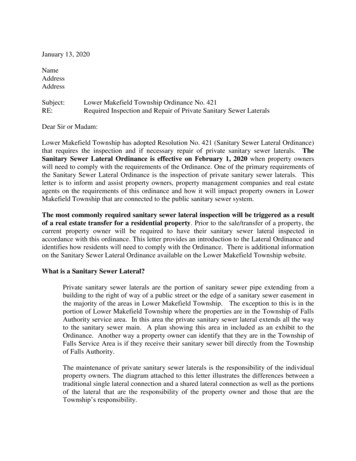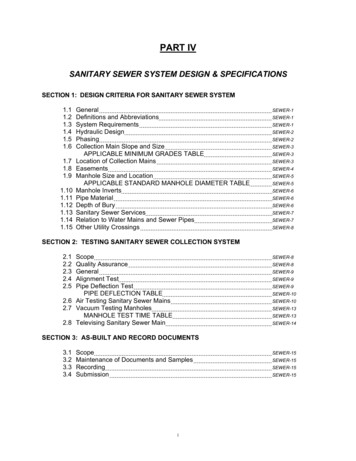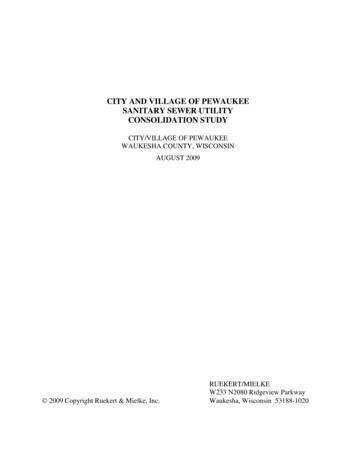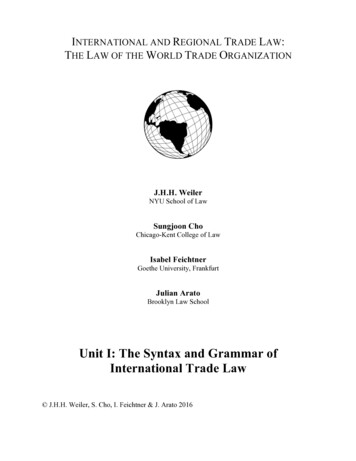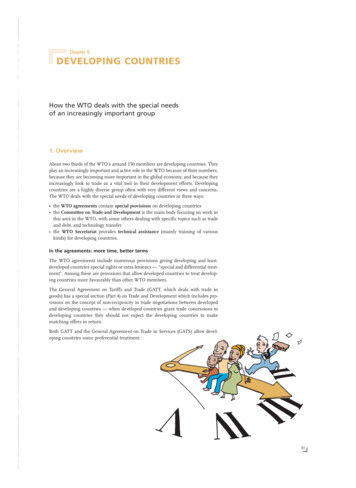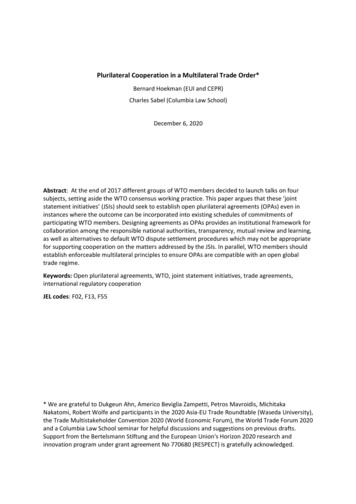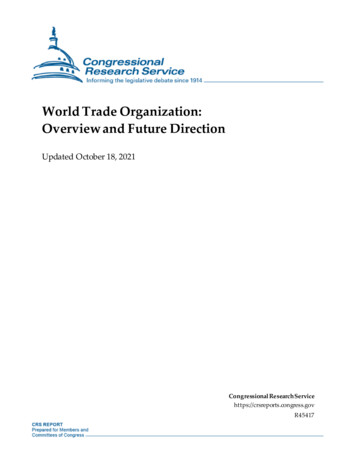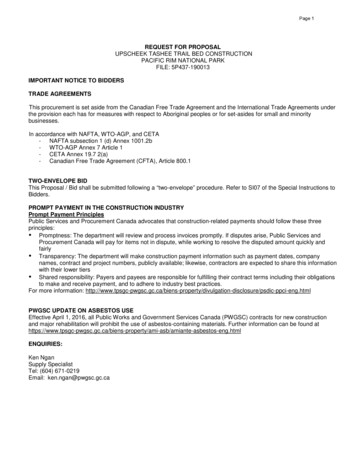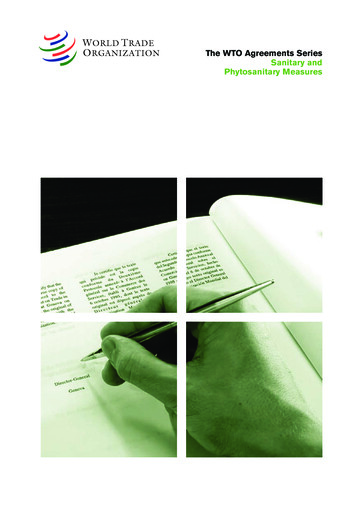
Transcription
The WTO Agreements SeriesSanitary andPhytosanitary Measures
The WTOagreements seriesThe WTO’s agreements are the legal foundation for the international trading system that isused by the bulk of the world’s trading nations. This series offers a set of handy referencebooklets on selected agreements. Each volume contains the text of one agreement, anexplanation designed to help the user understand the text, and in some cases supplementarymaterial. They are intended to be an authoritative aid for understanding the agreements,but because of the legal complexity of the agreements, the introductions cannot be takenas legal interpretations of the agreements.The agreements were the outcome of the 1986–1994 Uruguay Round of world tradenegotiations held under the auspices of what was then the GATT (the General Agreement onTariffs and Trade). The full set is available in The Results of the Uruguay Round of MultilateralTrade Negotiations: The Legal Texts. It includes about 60 agreements, annexes, decisions andunderstandings, but not the commitments individual countries made on tariffs and services. Afull package of agreements that includes over 20,000 pages of commitments is available fromWTO Publications in a 34-volume set, as well as a CD-ROM, The Results of the Uruguay Round.The volumes in this seriesAgreement Establishing the WTOAgricultureGATT 1994 and 1947Sanitary and Phytosanitary MeasuresTechnical Barriers to Trade
ContentsIntroduction3The basicstructure of WTOagreements5The SPSAgreement:An overview9Frequently-askedquestions13Agreement onthe Applicationof Sanitary andPhytosanitaryMeasures(the legal text)27Annexes to SPSAgreement37Abbreviations45
IntroductionThe Agreement on the Application of Sanitary and Phytosanitary Measures (the“SPS Agreement”) entered into force with the establishment of the World TradeOrganization on 1 January 1995. It concerns the application of food safety and animaland plant health regulations.This booklet discusses the text of the SPS Agreement as it appears in the Final Act of theUruguay Round of Multilateral Trade Negotiations, signed in Marrakesh on 15 April 1994.This Agreement and others contained in the Final Act, along with the General Agreementon Tariffs and Trade as amended (GATT 1994), are part of the treaty which establishedthe World Trade Organization (WTO). The WTO superseded the GATT as the umbrellaorganization for international trade.The WTO Secretariat has prepared this booklet to assist public understanding of theSPS Agreement. The first section of the booklet presents the basic structure of WTOagreements; the second looks at the key features of the SPS Agreement; the thirdaddresses a number of frequently-asked questions; and the fourth is the legal text of theagreement. The booklet is not intended to provide a legal interpretation of the agreement.Sanitary and Phytosanitary Measures3
The basic structure ofWTO agreementsThe conceptual frameworkBroadly speaking, the WTO agreementsfor the two largest areas of trade — goodsand services — share a common three-partoutline, even though the detail is sometimesquite different (see Figure 1). They start with broad principles: the GeneralAgreement on Tariffs and Trade (GATT) (forgoods), and the General Agreement onTrade in Services (GATS). The Agreementon Trade-Related Aspects of IntellectualProperty Rights (TRIPS) also falls into thiscategory although it has no additional parts.Figure 1: The basic structure of the WTO agreementsUmbrellaAgreement establishing the WTOGoodsServicesIntellectualpropertyBasic principlesGATTGATSTRIPSAdditional detailsOther goodsagreements andannexesServices annexesMarket accesscommitmentsCountries’schedules ofcommitmentsCountries’schedules ofcommitments (andMFN exemptions)Dispute settlementDISPUTE SETTLEMENTTransparencyTRADE POLICY REVIEWSSanitary and Phytosanitary Measures5
Then come additional agreementsand annexes dealing with the specialrequirements of specific sectors or issues.These deal with the following:For goods (under GATT)AgricultureRegulations for food safety, animaland plant health protection (SPS)Textiles and clothingProduct standards (technical barrier to trade)Investment measuresAnti-dumping measuresCustoms valuations methodsPreshipment inspectionRules of originFor GATS, the commitments state howmuch access foreign service providersare allowed for specific sectors, andthey include lists of types of serviceswhere individual countries say they arenot applying the “most-favoured-nation”principle of non-discrimination.Much of the Uruguay Round dealt with the firsttwo parts: general principles and principlesfor specific sectors. At the same time,market access negotiations were possiblefor industrial goods. Once the principles hadbeen worked out, negotiations could proceedon the commitments for sectors such asagriculture and services. Negotiations after theUruguay Round and before the Doha Roundbegan in 2001 focused largely on marketaccess commitments: financial services,basic telecommunications, and maritimetransportation (under GATS), and informationtechnology equipment (under GATT).Import licensingSubsidies and counter-measuresSafeguardsFor services (the GATS annexes)Movement of natural personsAir transportThe agreement in the third area of tradecovered by the WTO — on intellectual property— is at the level of basic principles althoughsome details on specific areas (for example oncopyright, patents, trademarks, geographicalindications) are handled in the agreement.Other details come from conventions andagreements outside the WTO.Financial servicesShippingTelecommunications Finally, there are the detailed and lengthyschedules (or lists) of commitmentsmade by individual countries allowingspecific foreign products or serviceproviders access to their markets. ForGATT, these take the form of bindingcommitments on tariffs for goods ingeneral, and combinations of tariffsand quotas for some agricultural goods.6WTO Agreements SeriesThe agreements on dispute settlement andtrade policy reviews are also essentially atthe level of basic principles.Also importantOne other set of agreements not includedin the diagram above is also important: thetwo “plurilateral” agreements not signed byall members: fair trade in civil aircraft andgovernment procurement. (Originally therewere four agreements, but those concerningdairy products and bovine meat wereterminated at the end of 1997.)
The legal frameworkThe conceptual structure is reflected in theway the legal texts are organized. The shortMarrakesh Agreement Establishing theWorld Trade Organization sets up the legaland institutional foundations. Attached toit is a much lengthier set of four annexes.Finally, the Marrakesh texts include anumber of decisions and declarations on awide variety of matters that were adopted atthe same time as the WTO Agreement itself. Annex 1 contains most of the detailedrules, and is divided into three sections:–– 1A, containing the revised GeneralAgreement on Tariffs and Trade,the other agreements governingtrade in goods, and a protocol whichties in individual countries’ specificcommitments on goods;–– 1B, the General Agreement on Tradein Services, texts on specific servicessectors, and individual countries’specific commitments and exemptions;and–– 1C, the Agreement on Trade-RelatedAspects of Intellectual Property Rights.Collectively, the agreements included inAnnex 1 are referred to as the MultilateralTrade Agreements, since they comprise thesubstantive trade policy obligations whichall the members of the WTO have accepted. Annex 2 sets the rules and proceduresfor dispute settlement. Annex 3 provides for regular reviews ofdevelopments and trends in national andinternational trade policy. Annex 4 covers the “plurilateral”agreements which are within the WTOframework but which have limitedmembership.Sanitary and Phytosanitary Measures7
The SPS Agreement:An overviewProblem: How do you ensure that yourcountry’s consumers are supplied with foodthat is safe to eat — “safe” at the level youconsider appropriate? And at the same time,how can you ensure that unnecessary healthand safety regulations are not used as anexcuse to protect domestic producers fromforeign competition?The Agreement on the Application ofSanitary and Phytosanitary Measures (“theSPS Agreement”) sets out the basic rulesfor food safety and animal and plant healthrequirements.It allows countries to set their own standards.However, it also specifies that regulationsmust be based on scientific findings andshould be applied only to the extent thatthey are necessary to protect human,animal or plant life or health; they shouldnot unjustifiably discriminate betweencountries where similar conditions exist.WTO member countries are encouraged touse the standards developed by the relevantinternational bodies whenever they exist.However, members may use measures whichresult in higher levels of health protection,so long as their measures are based on anappropriate assessment of risks and theapproach is consistent, not arbitrary.The agreement sets out a framework forwhat countries can do, but is not prescriptivein how countries use health standards andmethods of inspecting products.Key featuresAll countries maintain measures to ensurethat food is safe for consumers, and toprevent the spread of pests or diseasesamong animals and plants. These sanitaryand phytosanitary measures can take manyforms, such as requiring products to comefrom a disease-free area, inspection ofproducts, specific treatment or processing ofproducts, setting allowable maximum levelsof pesticide residues or limiting the permitteduse of additives in food. Sanitary (humanand animal health) and phytosanitary (planthealth) measures apply to domesticallyproduced food or local animal and plantdiseases, as well as to products coming fromother countries.Protection or protectionism?Sanitary and phytosanitary measures, bytheir very nature, may result in restrictions ontrade. All governments accept the fact thatsome trade restrictions may be necessaryto ensure food safety and animal and planthealth protection. However, governments aresometimes pressured to go beyond whatis needed for health protection and usesanitary and phytosanitary restrictions toSanitary and Phytosanitary Measures9
shield domestic producers from economiccompetition. A sanitary or phytosanitaryrestriction which is not actually requiredfor health reasons can be a very effectiveprotectionist device and, because of itstechnical complexity, it can be a particularlydeceptive and difficult barrier to challenge.The SPS Agreement builds on previous GATTrules to restrict the use of unjustified sanitaryand phytosanitary measures for the purposeof trade protection. The basic aim of the SPSAgreement is to maintain the sovereign rightof any government to provide the level ofhealth protection it deems appropriate, but toensure that this sovereign right is not misusedfor protectionist purposes and do not result inunnecessary barriers to international trade.In other words, it strikes a balance betweenthe right of governments to protect healthand their desire to see goods flow smoothlyin international trade.Justification of measuresThe SPS Agreement therefore permitsgovernments to maintain appropriate sanitaryand phytosanitary protection. At the same time,it reduces the possibility that decisions arearbitrary and encourages consistent decisionmaking. Sanitary and phytosanitary measuresmust be applied for no other purpose than toensure that food is safe and that animals andplants are healthy, or to protect a country’sterritory from pests. In particular, the agreementclarifies which factors should be taken intoaccount when risks are assessed. Measuresto ensure food safety and to protect the healthof animals and plants should be based as faras possible on the analysis and assessment ofobjective scientific data.International standardsTheSPSAgreementencouragesgovernments to apply national SPS measuresthat are consistent with internationalstandards, guidelines and recommendations.This process is often called “harmonization”.The WTO itself does not and will not developthese standards. However, most of theWTO’s member governments participate inthe development of these standards in otherinternational bodies by leading scientists inthe field and governmental experts on healthprotection. These standards are subject tointernational scrutiny and review.International standards are often higher thanthose actually applied in many countries,including developed countries, but the SPSAgreement explicitly permits governmentsto choose their own standards. However, ifthe national requirement results in a greaterrestriction of trade, a country may be askedby its trading partners to provide scientificjustification demonstrating that the relevantinternational standard would not achievethe level of health protection the countryconsiders appropriate.Adapting to conditionsDue to differences in climate, existing pestsor diseases, or food safety conditions, it isnot always appropriate to impose the samesanitary and phytosanitary requirements onfood, animal or plant products coming fromdifferent countries. Therefore, sanitary andphytosanitary measures sometimes vary,depending on the health situation in thecountry of origin or destination, of the food,animal or plant product concerned. This istaken into account in the SPS Agreement.Governments should also recognize pestand disease-free areas which may not10WTO Agreements Series
correspond to political boundaries, andadapt their requirements so that they areappropriate for products from these areas,an approach known as “regionalization”. Theagreement, however, prohibits unjustifieddiscrimination in the use of sanitary andphytosanitary measures, whether in favourof domestic producers or among foreignsuppliers.Alternative measures and“equivalence”An acceptable level of risk can often beachieved in alternative ways. Among thealternatives — and on the assumptionthat they are technically and economicallyfeasible and provide the same level offood safety or animal and plant healthprotection — governments should selectthose that do not restrict trade more thannecessary to meet their health objective.Furthermore, if another country can showthat the measures it applies provide thesame level of health protection, these shouldbe accepted as equivalent. This helps toensure that protection is maintained whileproviding the greatest quantity and varietyof safe foodstuffs for consumers, the bestavailability of safe inputs for producers, andhealthy economic competition. “Equivalence”is one of the subjects regularly discussed inthe SPS Committee.Risk assessmentCountries’ SPS measures must be based onan appropriate assessment of the actual risksinvolved. If asked, they must make knownwhat factors they took into consideration,the assessment procedures they used andthe level of risk they determined to beacceptable.TransparencyThe SPS Agreement makes sanitary andphytosanitary measures more transparent.Governments are required to notify eachother, through the WTO Secretariat, of anynew or changed sanitary and phytosanitaryrequirements which affect trade. Each WTOmember must also set up offices (called“Enquiry Points”) to respond to requests formore information on new or existing SPSmeasures, including how they justify theirrequirements and how they apply their foodsafety and animal and plant health regulations.By systematically communicating informationand exchanging experiences, WTO membergovernments can improve their nationalstandards. The increased transparencyalso protects consumers and tradingpartners alike from protectionism hiddenin unnecessary technical requirements.This information is now readily availablein a comprehensive online database, theSPS Information Management System(http://spsims.wto.org).SPS CommitteeA special committee has been establishedwithin the WTO as a forum for membergovernments to exchange informationon all aspects of the SPS Agreement’simplementation. The SPS Committeereviews how countries are complying withthe agreement, discusses issues that mayimpact on trade and maintains close cooperation with technical organizations in thefield. If a legal dispute arises on a sanitaryor phytosanitary measure, the normal WTOdispute settlement procedures are used,and advice from appropriate scientificexperts can be sought.Sanitary and Phytosanitary Measures11
Frequently-askedquestionsWhat are sanitary andphytosanitary measures? Doesthe SPS Agreement cover acountry’s measures to protectthe environment, its consumerinterests and animal welfare?“Sanitary” refers to human and animal health,including food safety, and “phytosanitary”means plant health. For the purposes of theSPS Agreement, sanitary and phytosanitarymeasures are defined as any measures applied: to protect human or animal life from risksarising from additives, contaminants,toxins or disease-causing organisms intheir food or beverages; to protect human life from plant- or animalcarried diseases (known as “zoonoses”); to protect animal or plant life from pests,diseases, or disease-causing organisms; to prevent or limit other damage to acountry from the entry, establishment orspread of pests.Sanitary and phytosanitary measuresinclude measures taken to protect thehealth of fish, forests and wildlife, as wellas farmed animals and plants.Some measures for environmentalmay fall within the scope ofAgreement (as defined above),to avoid contaminating drinkingprotectionthe SPSsuch aswater, toprevent farm soils or fish stocks from beingcontaminated by heavy metals, or to protectbiodiversity. Measures purely to protectconsumer interests or animal welfare arenot covered by the SPS Agreement. Theseconcerns, however, may be addressed by otherWTO agreements (i.e., the TBT Agreement –see below – or Article XX of GATT).Weren’t governments allowed toprotect food safety and animaland plant health before the SPSAgreement?Yes, since 1948, national food safety, animaland plant health measures which affecttrade were subject to GATT rules. One ofGATT’s most important principles is nondiscrimination. GATT’s first article (“mostfavoured nation”) says products importedfrom different WTO member countries mustbe treated equally. The third article says lawsand other requirements must not be tougheron imports than on domestically-producedproducts. These rules apply, for instance, topesticide residue and food additive limits,as well as to restrictions for animal or planthealth purposes. Article XI does not permitgovernments to impose import bans or limitson the quantities of imports permitted.The GATT rules also contain an exception(Article XX:b) which permits countriesSanitary and Phytosanitary Measures13
to take measures “necessary to protecthuman, animal or plant life or health” as longas these do not unjustifiably discriminatebetween countries where the sameconditions prevail, or are not a disguisedrestriction to trade. In other words, wherenecessary, for the purposes of protectinghuman, animal or plant health, governmentscould impose more stringent requirementson imports than they required of domesticgoods, and could ban imports that presenteda serious health risk.In the Tokyo Round of multilateral tradenegotiations (1974-79), an Agreement onTechnical Barriers to Trade was negotiated(the 1979 TBT Agreement or “StandardsCode”). Only some countries signed it.Although the primary purpose of thisagreement was not the regulation of sanitaryand phytosanitary measures, it covered alltechnical requirements including thoseresulting from food safety and animal andplant health measures, pesticide residuelimits, inspection requirements and labelling.Governments that signed the 1979TBT Agreement agreed to use relevantinternational standards (such as thosefor food safety developed by the CodexAlimentarius Commission), except whenthey considered that these standardswould not adequately protect health. Theyalso agreed to notify other governments,through the GATT Secretariat, of anytechnical regulations which were not basedon international standards. The 1979 TBTAgreement included provisions for settlingtrade disputes arising from the use of foodsafety and other technical restrictions.Postscript: The original GATT was revised as partof the 1986-94 Uruguay Round. The revision isofficially “GATT 1994”. It incorporates the original“GATT 1947”, much of which remains untouched. Therevised GATT is the WTO’s umbrella treaty for trade in14WTO Agreements Seriesgoods. Its rules apply when not superseded by a morespecific WTO agreement. For food safety and animaland plant health measures the rules of the SPSAgreement prevail over those of the updated GATT.The Uruguay Round also updated the TBT Agreement.The older 1979 version took effect on 1 January1980. At the end of 1994, before it was supersededby the new version, its signatories were the EuropeanUnion (12 countries at the time, plus 8 countries whichsubsequently became members) and 26 others. TheUruguay Round made two broad changes: the WTOTBT Agreement revised the original version, and hasbeen signed by all WTO members as part of the“single undertaking”, which also includes the SPSAgreement and the majority of WTO treaties.Why have an SPS Agreement?Because sanitary and phytosanitarymeasures can so effectively restrict trade,WTO member governments want to haveclear rules on how they can be used. Whenthey negotiated the Uruguay Round, theywanted to reduce trade barriers, includingthrough the Agriculture Agreement.This increased fears that sanitary andphytosanitary measures might be used forprotectionist purposes.The SPS Agreement is designed to close thispotential loophole. It sets out clearer, moredetailed rights and obligations for food safetyand animal and plant health measures whichaffect trade. Countries are permitted to imposeonly those requirements needed to protecthealth which are based on scientific principles.A government can challenge another country’sfood safety or animal and plant healthrequirements on the grounds that they are notjustified by scientific evidence. When asked,a country must make its procedures anddecisions available to others. Governmentshave to be consistent in their decisions on
what safe food is and in their responses toanimal and plant health concerns.How do you know if a measureis SPS or TBT? Does it makeany difference?The scope of the two agreements is different(see Figure 2). The SPS Agreement covers allmeasures whose purpose is to protect: human or animal health from food-bornerisks; human health from animal- or plantcarried diseases; animals and plants from pests or diseases; the territory of a country from damagecaused by pests;whether or notrequirements.thesearetechnicalThe TBT (Technical Barriers to Trade)Agreement covers all technical regulations,voluntary standards and the procedures toensure that these are met, except when theseare sanitary or phytosanitary measures asdefined by the SPS Agreement.The type of measure determines whether it iscovered by the TBT Agreement. The purposeof the measure is relevant in determiningwhether it is subject to the SPS Agreement.TBT measures can cover any product, fromcar safety and energy-saving devices, to theshape of food cartons. To give some examplespertaining to human health, TBT measurescould include pharmaceutical restrictions, orthe labelling of cigarettes.Most measures to control human diseasecome under the TBT Agreement, unless theyconcern diseases which are carried by plantsor animals (such as rabies or BSE). For food,most labelling requirements, information onnutrition and quality and packaging regulationsare generally not considered to be sanitaryor phytosanitary measures and hence arenormally subject to the TBT Agreement.On the other hand, regulations which addressthe microbiological contamination of food, orset allowable levels of pesticide or veterinarydrug residues, or identify permitted foodadditives, fall under the SPS Agreement.Some packaging and labelling requirements,if directly related to the safety of the food,are also subject to the SPS Agreement.The two agreements share some commonelements. These include basic obligations notto discriminate. They both require governmentsto notify proposed measures in advance. Bothrequire governments to set up informationoffices (“Enquiry Points”). Nonetheless,many of the substantive rules are different.For example, both agreements encouragegovernments to use international standards.However, under the SPS Agreement, if agovernment wants to set its own standards forfood safety or to protect animal and plant health,it has to base this on a scientific assessmentof the potential health risks. In contrast,under the TBT Agreement, governments canuse other justifications, such as fundamentaltechnological reasons or geographical factors,to set their own standards.In addition, sanitary and phytosanitary measurescan only be used when necessary to protecthuman, animal or plant health, on the basis ofscientific information. However, governmentscan use TBT regulations when necessary tomeet a number of objectives, such as nationalsecurity or to prevent deceptive practices. Theobligations that governments have acceptedare different under the two agreements, andtherefore it is important to know whethera measure is a sanitary or phytosanitarymeasure, or comes under the TBT Agreement.Sanitary and Phytosanitary Measures15
Figure 2: SPS or TBT?Which agreement does a measure come under?Is it food, drink or feed, and is its objective to protect one of those from these risks?human lifeanimal life additives,contaminants,toxins ordisease-causingorganisms infood or drink plant- or animalcarried disease additives,contaminants,toxins ordisease-causingorganisms infeed or drink diseases disease-causingor diseasecarryingorganismsYESplant life pests diseases disease-causingor diseasecarryingorganismsa country pests entering,establishing orspreadingNOIs it a technical regulation, standard orprocedure for assessing whether a productconforms with a standard?NOOTHERYESSPSTBTExamplesFertilizerFood labelling16WTO Agreements SeriesRegulation on permitted fertilizer residue in food andanimal feedSPSSpecifications to ensure fertilizer works effectivelyTBTSpecifications to protect farmers from possible harmfrom handling fertilizerTBTRegulation on permitted food safety: health warnings,use, dosageSPSRegulation on size, construction/structure, safe handlingTBT
ExamplesFruitBottled water:specifications forthe bottlesCigarette packetsRegulation on treatment of imported fruit to preventpests spreadingSPSRegulation on quality, grading and labelling of importedfruitTBTMaterials that can be used because safe for humanhealthSPSRequirements: no residues of disinfectant, so water notcontaminatedSPSPermitted sizes to ensure standard volumesTBTPermitted shapes to allow stacking and displayingTBTGovernment health warning: “Smoking can seriouslydamage your health”: the label’s objective is health butit is not about food, so it is not SPSTBTTo summarizeSPS measures typically deal with:TBT measures typically deal with: additives in food or drink labelling of food, drink and drugs contaminants in food or drink grading and quality requirements for food poisonous substances in food or drink packaging requirements for food residues of veterinary drugs or pesticides packaging and labelling for dangerousin food or drinkchemicals and toxic substances certification: food safety, animal or plant regulations for electrical applianceshealth processing methods with implications for regulations for cordless phones, radiofood safetyequipment, etc. labelling requirements directly related to textiles and garments labellingfood safety plant/animal quarantine testing vehicles and accessories declaring areas free from pests or regulations for ships and ship equipmentdisease preventing disease or pests spreading safety regulations for toysto a country other sanitary requirements for imports etc (e.g. imported pallets used to transportanimals) etc Sanitary and Phytosanitary Measures17
How do governments and thepublic know who is doing what?The transparency provisions of the SPSAgreement are designed to ensure thatthe public and trading partners know aboutmeasures taken to protect human, animaland plant health. The agreement requiresgovernments to promptly publish all sanitaryand phytosanitary regulations. When othergovernments ask, they have to explain thereasons for any particular food safety oranimal or plant health requirement.All WTO member governments mustmaintain an Enquiry Point, an officedesignated to receive and respond toany requests for information regardingthat country’s sanitary and phytosanitarymeasures. Such requests may be for copiesof new or existing regulations, information onrelevant agreements between two countries,or information about risk assessmentdecisions. Contact details for Enquiry Pointscan be consulted electronically through theSPS Information Management System (SPSIMS – http://spsims.wto.org).Whenever a government is proposing anew regulation (or modifying an existingone) which differs from an internationalstandard and may affect international trade,it must notify the WTO Secretariat, whichthen circulates the notification to other WTOmember governments. The notifications arealso available to the public on the WTO website’s Documents Online G/SPS/N/”), or through the SPSInformation Management System (http://spsims.wto.org). Alternatively, notificationscan be requested from the Enquiry Point ofthe country which is proposing the measure.Governments have to submit the notificationbefore a proposed new regulation isimplemented, so that trading partners18WTO Agreements Serieshave an opportunity to comment. The SPSCommittee has developed recommendationson how the comments must be hand
The full set is available in The Results of the Uruguay Round of Multilateral Trade Negotiations: The Legal Texts. It includes about 60 agreements, annexes, decisions and . were four agreements, but those concerning dairy products and bovine meat were terminated at the end of 1997.) For goods (under gATT) Agriculture


